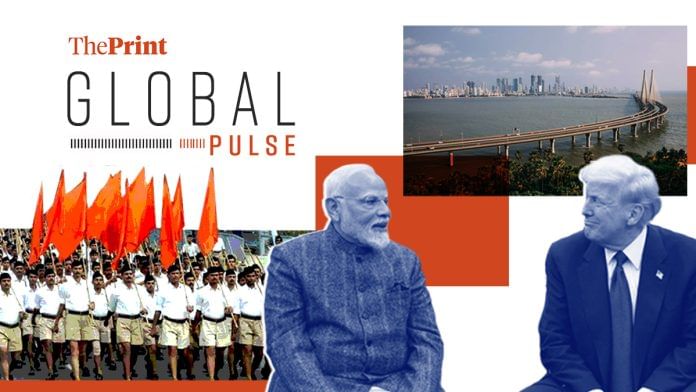New Delhi: The Rashtriya Swayamsevak Sangh (RSS) has officially marked 100 years of its foundation. In the BBC, Samira Hussain covers the celebratory event in Nagpur, which saw about 3,800 volunteers in attendance, and looks at how even 100 years on, the RSS remains as opaque as ever.
“In a speech at RSS headquarters in the western city of Nagpur, its chief Mohan Bhagwat addressed a range of topics, including the conflict with Pakistan earlier this year, climate change, economic inequality and political turmoil in India’s neighbouring countries,” says the report.
“It’s an extremely complex organisational network,” Tanika Sarkar, a visiting professor at Ashoka University, tells the BBC. “It is a sprawling network which is difficult to characterise and difficult also to identify clearly, because you never know where the RSS ends and the other far-right organisations begin.”
The reports underlines that it is difficult to characterise the RSS. “It is not easy to pinpoint exactly what makes the RSS. It operates several charitable programmes such as schools, health clinics and its members are often on the scene to help during natural disasters, organising volunteers and distributing aid,” it notes.
In Financial Times, Krishn Kaushik reports on the new “billionaires’ row” on a single street in Mumbai, the Worli Sea Face.
Billionaires Uday Kotak and Dilip Shanghvi just bought properties in the area––and Mukesh Ambani’s daughter Isha is already a resident.
For India’s wealthiest, “Worli Sea Face today is the place to be”, Gulam Zia, a senior executive director with property consultant Knight Frank, tells the FT.
Naman Xana Tower, a once “dilapidated” bungalow in the area, has been reupholstered into one of India’s most coveted pieces of real estate. “Four of India’s richest families have bought at least seven of the 16 apartments in the 24-storey building,” Jayesh Shah, chair of the Shree Naman Group, is quoted as saying.
“The rich want a good community,” said Shah, adding that “the ultra-rich only want exclusivity and privacy”. Each floor has 6,000 square feet and views of the Arabian Sea, according to the report.
“Worli, once home to the cotton mills that were the city’s economic backbone and more recently to office complexes, is at the heart of a redevelopment that began more than two decades ago and includes metros, an airport and a seaport,” the report says.
In The New Yorker, Isaac Chotiner interviews Milan Vaishnav, a senior fellow and director of the South Asia programme at Carnegie Endowment for International Peace, on the “stunning reversal in US-India ties”.
The plummeting ties, he believes, has “to do with this White House’s view of the global order and geopolitics, and second, it has to do with the personality of the President (Donald Trump) himself”.
When asked how Prime Minister Narendra Modi tried to deal with Trump personally, Vaishnav tells Chotiner: “After the (India-Pakistan) ceasefire (in May), Modi was on the backfoot. There were many people, particularly in the BJP base, who had criticised him for stopping the conflict when he did. Pakistan (initially) had the upper hand and had shot down a still unknown number of Indian aircraft.”
“But, after that, most military analysts believe that the Indian military performed quite well and that Pakistani military installations were severely damaged,” he added.
“The idea that, in the wake of this, Modi was going to acknowledge that a third party essentially had a role in bringing this conflict to an end was just politically unpalatable. Now, in hindsight, I think there was probably a way for Modi to have done this by saying something as simple as, ‘we thank President Trump for putting an end to yet another bout of Pakistani military adventurism’, or something to that effect. But he didn’t do that,” Vaishav tells Chotiner.
“And, as time went on, it became harder and harder for him to do that, from a domestic political position.”
The Economist poses a critical question: Can India strike a deal on Russian oil to appease America? Currently, “the two strongmen are locked in a stalemate”, it says referring to Modi and Trump.
“How might India handle Mr Trump’s ultimatum on its oil purchases from Russia? Some analysts hope that Mr Trump’s short attention span might mean that Russian oil becomes less of an issue when another global crisis steals his focus. Others suggest that there is a deal to be done in which Mr Trump lets India buy some sanctioned Russian military kit in exchange for reducing oil purchases,” says the report.
What could work in favour of both parties is a trade deal, writes The Economist. But only if the oil issue can be cast aside. An arms deal could be hashed out too. But, the magazine points out, the larger question is whether this splinter in ties is permanent.
“American officials say that fixing the question of Russian oil will put relations right back on track. Indian officials, putting on a brave face, echo those talking points in public. But dig deeper, and it is apparent that months of diplomatic turbulence have unravelled a quarter-century of painstaking diplomatic work to build trust between the countries,” says the report.
(Edited by Nida Fatima Siddiqui)
Also Read: Global media analyses India’s ‘animal problems’ & the right to a legible doctor’s prescription






